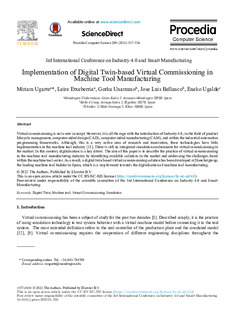| dc.rights.license | Attribution-NonCommercial-NoDerivatives 4.0 International | * |
| dc.contributor.author | Ugarte Querejeta, Miriam | |
| dc.contributor.author | Etxeberria, Leire | |
| dc.contributor.other | Unamuno Eguren, Gorka | |
| dc.contributor.other | Bellanco, Jose Luis | |
| dc.contributor.other | Ugalde, Eneko | |
| dc.date.accessioned | 2022-03-08T15:56:29Z | |
| dc.date.available | 2022-03-08T15:56:29Z | |
| dc.date.issued | 2022 | |
| dc.identifier.issn | 1877-0509 | en |
| dc.identifier.other | https://katalogoa.mondragon.edu/janium-bin/janium_login_opac.pl?find&ficha_no=166803 | en |
| dc.identifier.uri | https://hdl.handle.net/20.500.11984/5485 | |
| dc.description.abstract | Virtual commissioning is not a new concept; However, it is all the rage with the introduction of Industry 4.0, in the field of product lifecycle management, computer-aided design (CAD), computer-aided manufacturing (CAM), and within the industrial automation programming frameworks. Although, this is a very active area of research and innovation, these technologies have little implementation in the machine tool industry [11]. There is still no integrated simulation environment for virtual commissioning in the market. In this context, digitalisation is a key driver. The aim of this paper is to describe the practice of virtual commissioning in the machine tool manufacturing industry by identifying available solutions in the market and addressing the challenges faced within the machine tool sector. As a result, a digital twin based virtual commissioning solution has been developed at Danobatgroup, the leading machine tool builder in Spain, which is a step forward towards the digitalisation of machine tool manufacturing. | en |
| dc.description.sponsorship | Comisión Europea | es |
| dc.language.iso | eng | en |
| dc.publisher | Elsevier B.V. | en |
| dc.rights | © 2022 by the authors | en |
| dc.rights.uri | http://creativecommons.org/licenses/by-nc-nd/4.0/ | * |
| dc.subject | digital twin | en |
| dc.subject | Machine tool | en |
| dc.subject | virtual commissioning | en |
| dc.subject | simulation | en |
| dc.title | Implementation of Digital Twin-based Virtual Commissioning in Machine Tool Manufacturing | en |
| dcterms.accessRights | http://purl.org/coar/access_right/c_abf2 | en |
| dcterms.source | Procedia Computer Science | en |
| local.contributor.group | Ingeniería del software y sistemas | es |
| local.description.peerreviewed | true | en |
| local.description.publicationfirstpage | 527 | en |
| local.description.publicationlastpage | 536 | en |
| local.identifier.doi | https://doi.org/10.1016/j.procs.2022.01.250 | en |
| local.relation.projectID | info:eu-repo/grantAgreement/EC/H2020/814078/EU/Digital Manufacturing and Design Training Network/DiManD | en |
| local.contributor.otherinstitution | https://ror.org/003qafx79 | es |
| local.contributor.otherinstitution | https://ror.org/033vryh36 | es |
| local.source.details | Vol. 200. Pp. 527-536, 2022 | en |
| oaire.format.mimetype | application/pdf | |
| oaire.file | $DSPACE\assetstore | |
| oaire.resourceType | http://purl.org/coar/resource_type/c_c94f | en |
| oaire.version | http://purl.org/coar/version/c_970fb48d4fbd8a85 | en |








